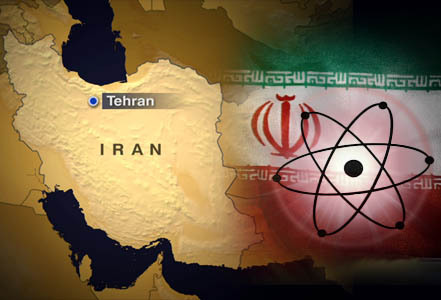Attack On Iranian Nuclear Program Could Lead To Up To 70,000 Civilian Casualties
At The Atlantic, Golnaz Esfandiari takes note of a new report that attempts to determine the impact an military strike on Iran’s nuclear program could have on Iranian civilians:
Experts believe the Isfahan uranium-conversion facility — which contains an estimated 371 metric tons of uranium hexafluoride — is one of the four Iranian sites likely to be targeted if Israel or the United States were to decide to take military action in an effort to delay or cripple Iran’s nuclear program. The University of Utah’s Hinckley Institute of Politics and the NGO Omid for Iran teamed up to produce a study that concludes that a military strike on the facility could have tragic consequences for Maryam and thousands of other residents of her centrally located city, which has a population of 2 million.
It’s unlikely that Maryam would die as an immediate result of such a bomb attack. But she could be among the estimated up-to-70,000 people who would be killed or injured after being exposed to toxic plumes released as the result of such strikes. They would reach the city within an hour. Such a scenario would mean that the people of Isfahan could experience a catastrophe similar to the gas leak in Bhopal or the nuclear meltdown at Chornobyl, says Khosrow Semnani, the author of the report, which is titled, “The Ayatollah’s Nuclear Gamble.”
“People’s skin could be burnt [when coming in contact with the plumes], they could become blind, their lung could be destroyed, their kidneys could be damaged, and in the future they could face other health problems such as skin cancer and [other forms] of cancer,” Semnani says. The report analyzed the impact of preemptive conventional strikes on four key nuclear sites: Isfahan’s uranium conversion facility; Natanz’s fuel-enrichment plant; Arak’s heavy-water plant; and Bushehr’s nuclear power plant. Workers at those sites — who include scientists, workers, support staff, and soldiers — would be among the first victims of a bombing campaign. The report estimates that the casualty rate at the sites would be close to 100 percent.
“According to our estimates, the number of casualties of the bombing of the four sites would be about 5,000 people,” Semnani says. “If the bombing would include more than those four sites, then the immediate casualty would be up to 10,000 people.” The report warns that the grim scenario could be magnified by the lack of readiness on the part of Iranian authorities, who have a poor record of disaster management and who lack the capacity to handle deadly radioactive fallout in the aftermath of a strike on its nuclear sites.
Afshin Molavi, an Iran expert and a senior fellow at the New America Foundation, says the study fills a gaping vacuum in Western discussions about military strikes on Iran, which often ignore the human cost of such actions. “People talk very callously about the prospect of military strikes, and they frame it in the geopolitical fallout, the geo-economic fallout, what will happen to the oil price and all of these issues. But nobody has ever talked about the humanitarian consequences of a military strike on Iran,” Molavi says. “Those humanitarian consequences are grave, so I think this report fills a very important vacuum. It needs to be read by policy makers at the highest levels in Western governments; it needs to be read in Israel; it needs to be read all over the world.”
Indeed it does.
We have already created enemies around the world thanks to indiscriminate drone attacks, bombing, and other tactics. During the Vietnam War, the civilian population largely turned against us because of the manner in which our military actions were leading to the deaths of non-combatants. Is it really worth the death or injury of as many as 70,000 people to follow the bidding of Benjamin Netenyahu and those here in the United States who never met a war they didn’t like, especially when it’s still not clear that our vital national interests are threatened by Iran in a manner that requires us to go to war? More importantly, do we really want to create another generation of enemies who very well may decide to bring the war to our own shores again? The Iranian people most assuredly do not deserve to be punished for the actions of their government, and I’d hope that someone would consider this report before blindly sending us off into yet another war.
H/T: Andrew Sullivan







I’ve been pointing this out for the last six or seven years. Iran’s nuclear development and research facilities aren’t located in their equivalent of Los Alamos or even Oak Ridge. They’re in their equivalents of the University of Chicago football stadium. You can’t attack their nuclear development program without attacking their cities.
you have balls
There you go again, you far-left, loopy liberal. Asking questions and not blindly following Israel’s demands. You are nothing but an anti-Semite, hell bent on apologizing for American greatness. Who gives a sh!t what the world thinks? If they are not with us, they are against us. And we will deal with them in due time. Who cares if thousands of non-Americans die due to our actions? Who cares if some day it comes back to bite us on our soil? That just gives us another excuse to bomb them back to the stone age. WE MUST FORCE THE WORLD TO FEAR OUR GREATNESS!
you have overreaction
I’ll go ahead and jump the gun on Tsars response.
Ahem
“This won’t be the first time reality blindside liberals. What’s really ironic is the that the man won’t even realize how lucky we would be to take out these civilians. A few thousand dead really serve to clean out the system if you catch my drift. At least this would do wonders for the price of oil.”
I skimmed the report and it’s got some significant problems. I’ll just give two examples:
– al Tuwaitha, the Iraqi nuclear center just outside of Baghdad, was bombed several times during Desert Storm, and contained many facilities similar to those in Iran. al Tuwaitha isn’t even mentioned in this report. By contrast, the report cites Bhopal frequently and uses it as a model to estimate casualties from a strike on Iran’s facilities. I don’t know the author’s rationale for failing to even mention Tuwaitha, but it’s a glaring and negligent omission.
– The report assumes that “close to 100%” of all the on-shift workers at each facility would be killed in a strike. For Isfahan that’s estimated at 800-1000 people killed by five – yes five – conventional bombs. Not going to happen. The author estimates 10000 total killed just from this silly assumption. As an estimate it’s not even in the ballpark considering the munitions involved, the weapons effects, and the likely timing of the strike. The author makes similar very questionable assumptions with regard to secondary effects and “conservatively” assumes a further 12,000-70000 civilians killed in the city of Isfahan. Again, from five bombs in a large industrial complex. This is a not credible estimate. Again, al Tuwaitha was closer to a much larger city and had dozens of bombs dropped on it during desert storm.
There’s no doubt that a lot of people would die in any attack on Iran as well as whatever follows, but this report does not provide a credible estimate for potential casualties.
@Neil Hudelson: Wow! I could almost hear his imaginary voice!
“Workers at those sites — who include scientists, workers, support staff, and soldiers — would be among the first victims of a bombing campaign”
http://www.youtube.com/watch?v=dGOVbXF7Iog
@Andy:
We bombed Iran during Desert Storm?
Andy, reread this, especially the italicized parts:
I have to think this is the low end.
Possibly it’s the high-end for deaths via airstrike. But do we really believe that it’ll be airstrikes and done?
[also, too: sanctions hurt civilians too. Not as much as bombing them, perhaps, but it’s not like we’re doing nothing to harm Iranian civilians right now]
@OzarkHillbilly:
My point is that we actually have a historical case study for bombing nuclear facilities similar to those Iran, and that case study is Al Tuwaitha, Iraq. The author of this study doesn’t even mention Tuwaitha, but instead uses Bhopal as a case study in order to calculate potential casualties which he “conservatively” estimates at up to 70k for Isfahan.
My point is that if one is going to examine the potential effects of an attack on Iran, then one should at least include Tuwaitha since it is, quite obviously, the most comparable historical event we have.
@Rob in CT:
That´s the problem. And that´s why Romney is losing. No one wants another Mid East War.
Slightly OT, but there was an interesting article in the FT today about the increasing possibility of Iran to start attacking ships passing through the Straits of Hormuz. It’s usually been considered the Iran won’t do anything to render the straits impassable because of their own oil shipping, but considering that Iran’s own production has been dwindling, there’s the worry that Iran will feel there’s no cost on its own side.
Thinking about it more, Iran would have to be totally brain-damaged to do this. If there’s anything that would get countries like China on the side of an international contingent to attack Iran, it would be Iran attempting to close down Hormuz.
@grumpy realist:
I haven’t looked in a couple of years, but the last time I checked about 80% of Iran’s petroleum exports pass through the Kharq Island terminal in the northern Persian Gulf. If Iran decides to close the strait, it will cut off this terminal as well as the others in the Gulf. The petroleum sector is something like 20% of Iran’s total GDP, so yeah, Iran would cut off its own leg by closing the strait.
@Andy: Your comparison to Al Tuwaitha is incorrect and omits critical details. As it was discovered in post-2003 invasion of Iraq, no WMD were found in the country and the Al Tuwaitha site was a construction site not that different from Osarik. It was not operational and the IAEA had no record of this site being a “nuclear facility” similar to the Iranian sites we examined in our report.
Further, our report (on Page 5) clearly mentions the assumptions and variables that could impact the estimates. Under the identified strategic and tactical intentions, we factor the following variables:
1. The facilities targeted;
2. The timing and duration of the strike;
3. The number, type and accuracy of weapons used;
4. The quality of intelligence for targeting;
5. The amount of advance warning before the strikes;
6. Topography, construction and defense of each target’s nature, amount and composition of toxic materials released, including distribution and absorption of toxins and radioactive materials;
7. Topography of the vicinity around sites and prevailing climate conditions at the time of the strike, including wind patterns, humidity, rainfall and population densities and concentrations at and around targets within the radius of strikes;
8. The Iranian government’s plans, preparedness and defense systems designed to respond to attacks;
9. Quality of intelligence in anticipating timing and nature of attacks;
10. Access and ability to implement defensive measures against attacks, including civil defense and emergency response capabilities, and public education and awareness.
We have defined casualties as the sum total of fatalities and injuries resulting from exposure to the physical, thermal, chemical and radiological consequences of military strikes on Iran’s nuclear installations. Considering these variables, we have been very conservative and balanced in our estimates.
We should consult with our allies before we act in a way that may break ties. The last thing we need is more enemies.
@Omid for Iran: I’m not talking about 2003, I’m talking about 1991. The Iraqi’s DID have a covert nuclear weapons program at al Tuwaitha at that point – which is why I specifically mentioned desert storm.
@Omid for Iran:
Yes, you “factor” the variables, but I don’t agree with your methodology. Again, to point out one instance, how can you assume that five 2000 pound munitions dropped on a large industrial complex will kill close to 100% of the employees? You’ve made that assumption for every facility struck. I think you need to educate yourself on actual weapons effects before you make such assumptions and examine the history of these weapons used in actual strikes on actual facilities and estimate casualties based on that.
And again, not even a single mention of the multiple bombing raids against al Tuwaitha during the 1991 war nor the 2003 war…..
All I can say if for the Pres to get on the TV and Radio before he bombs. TEll the folks of Iran that in x amount of hours we’ll bombs the facilities. Let that time expire and send in the missles and B-2 bombers . Maybe an ICBM with a conventional war head. In any event if the people fail to move out of harms way so be it. The Iranian government wil be the one that should take the heat for it’s pursuit of NUCS